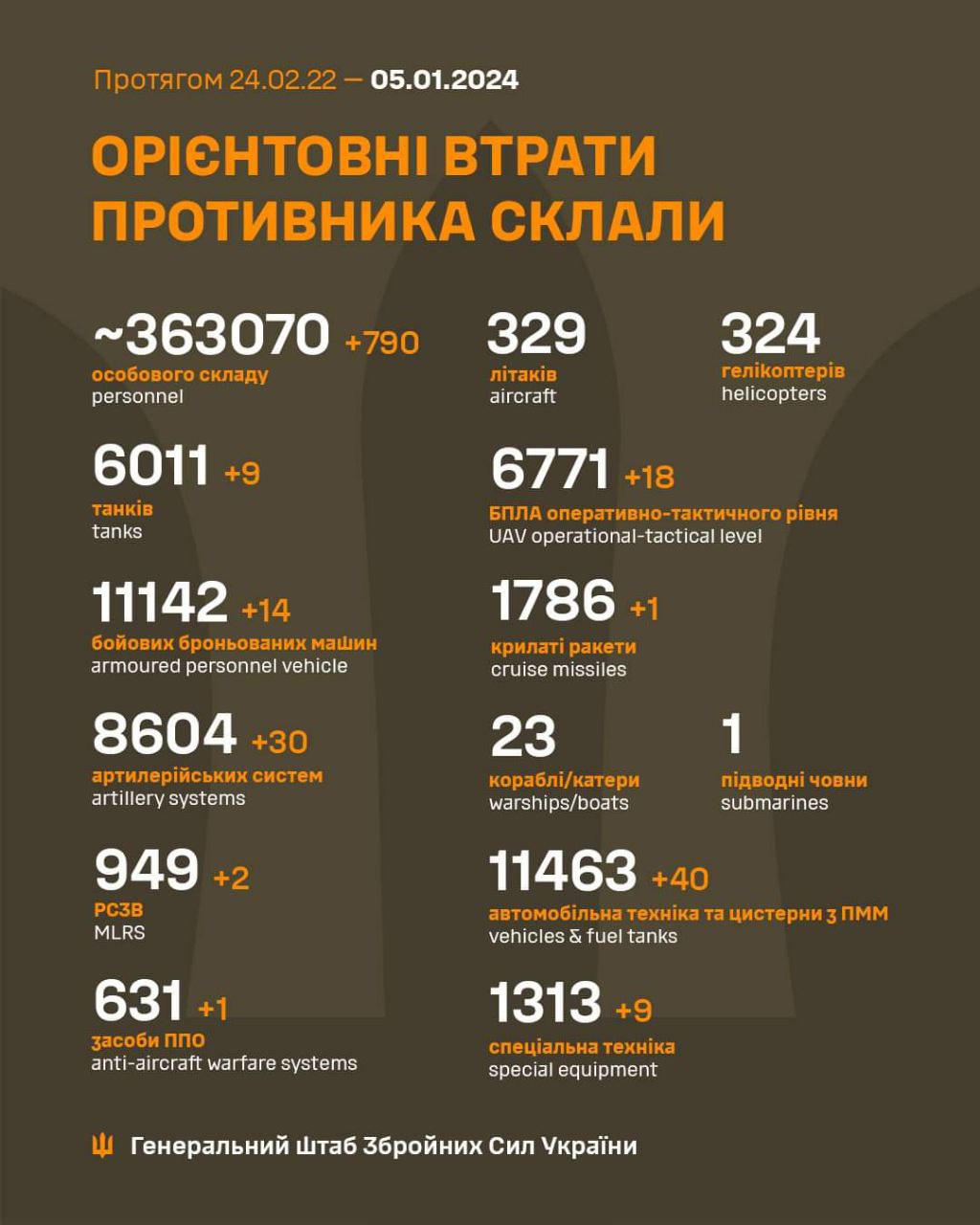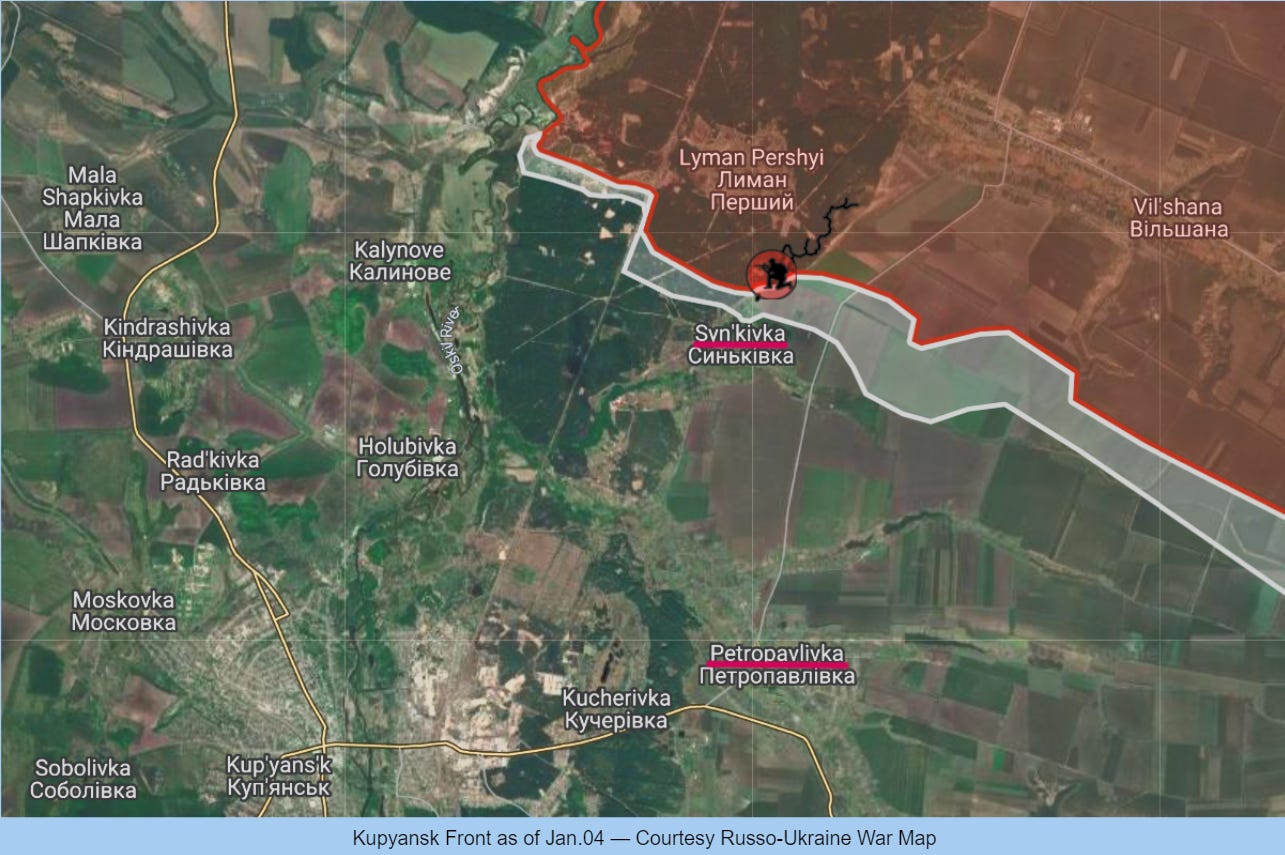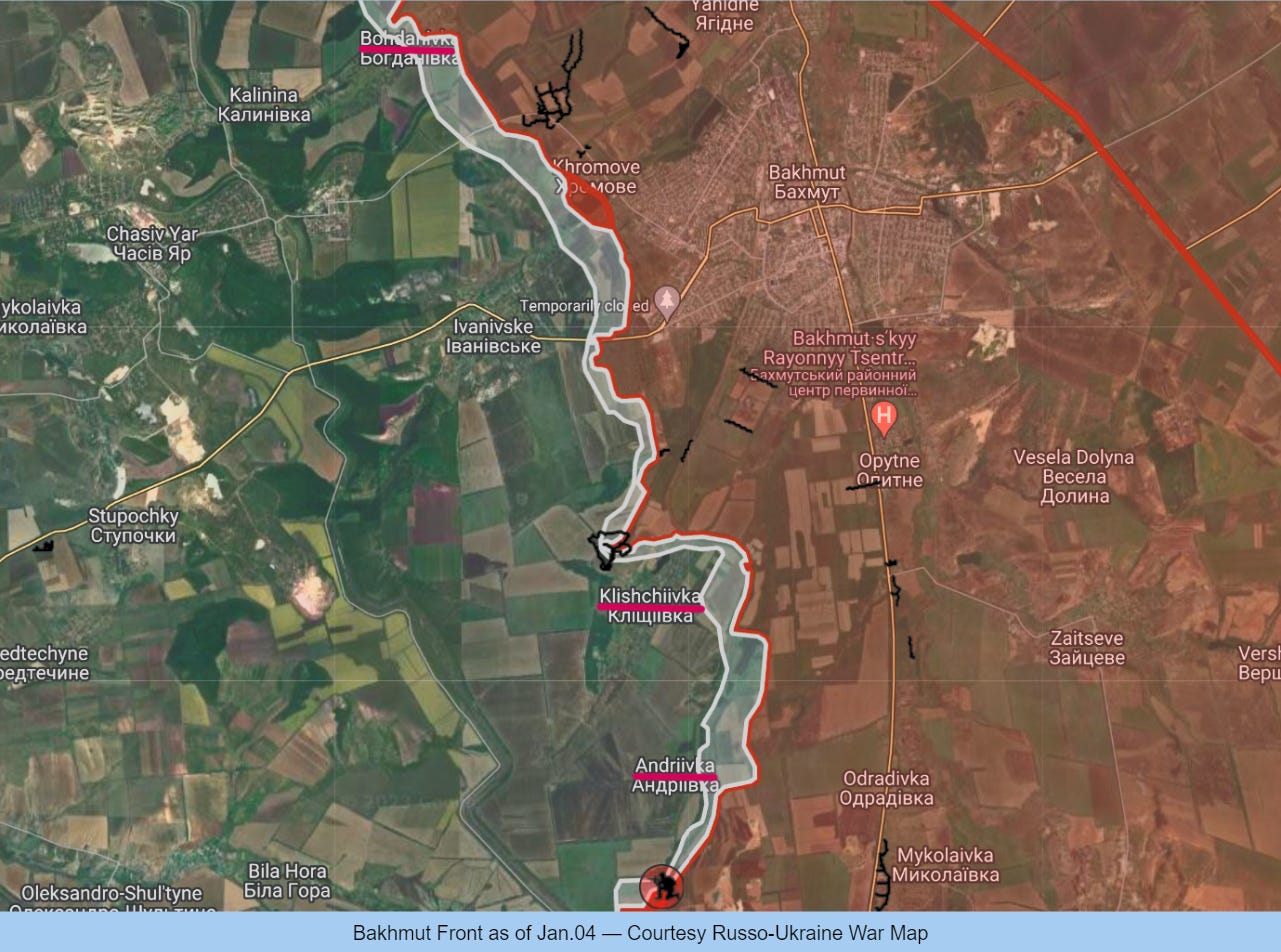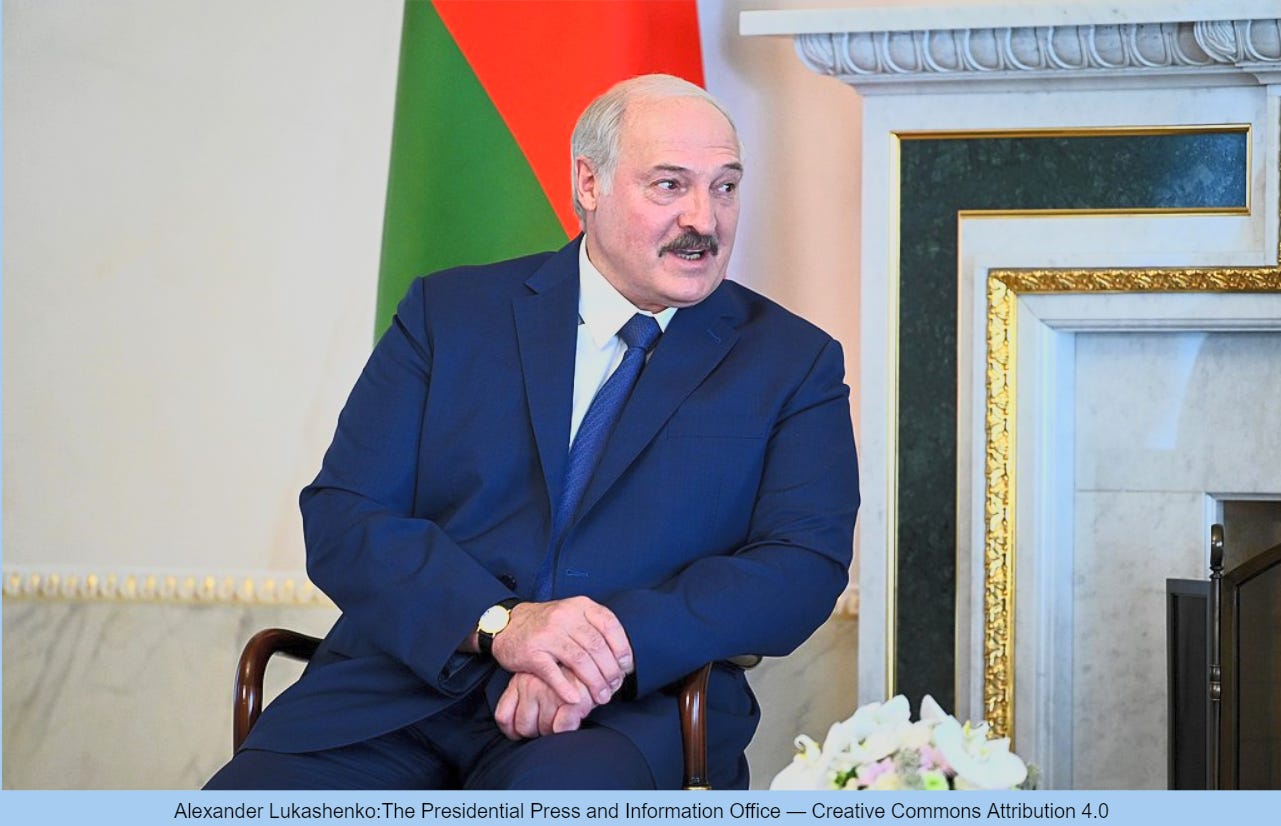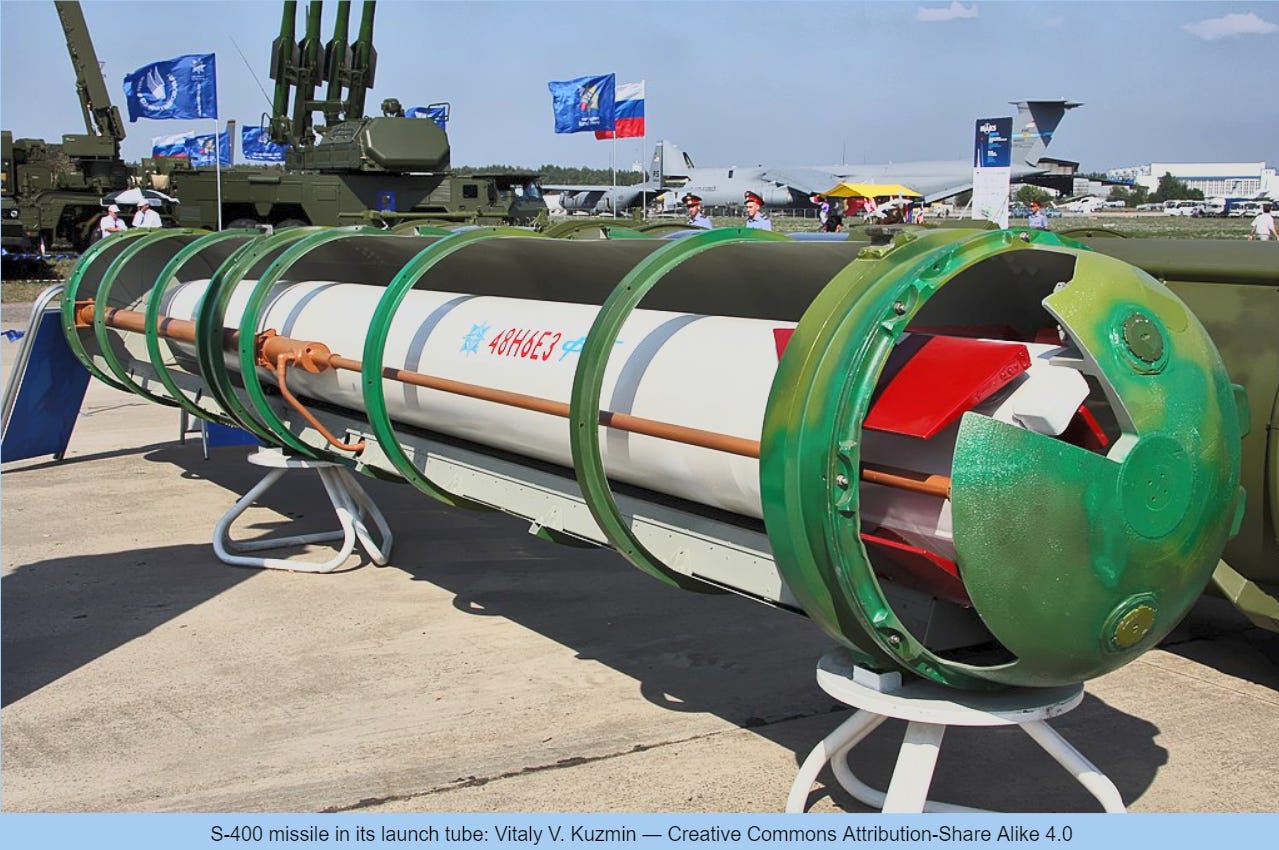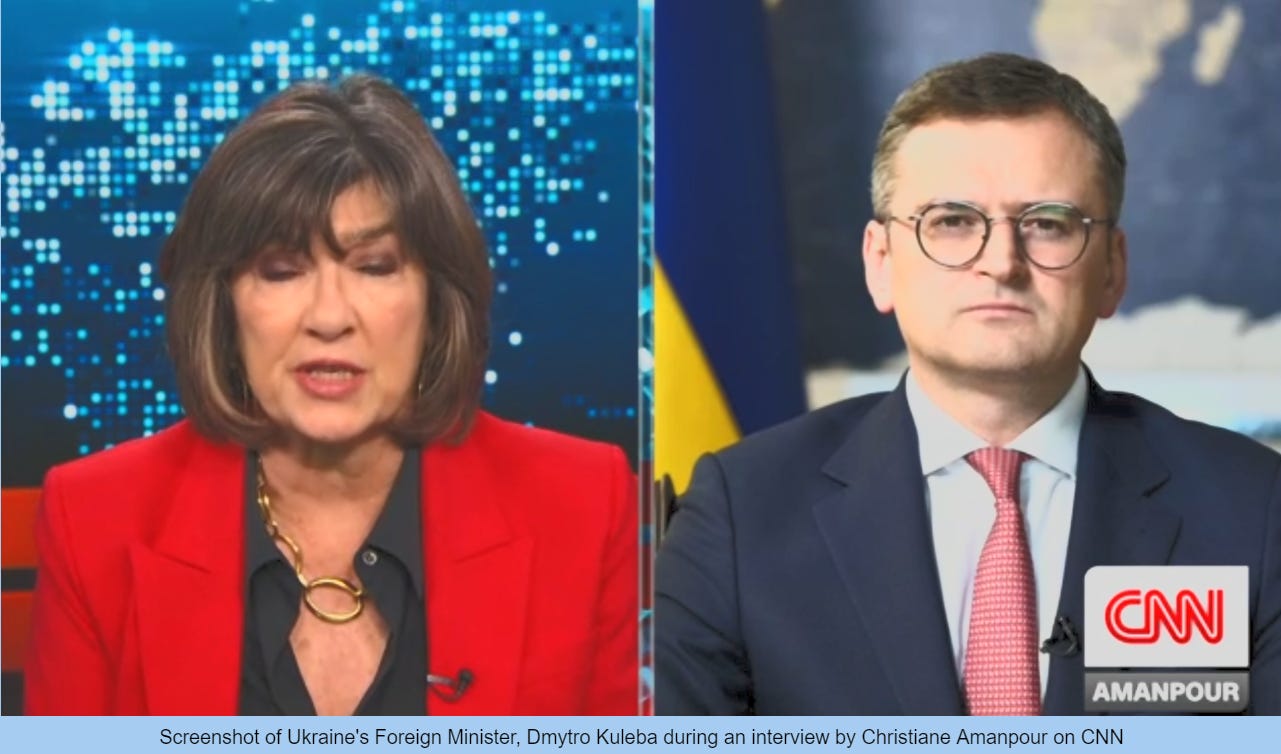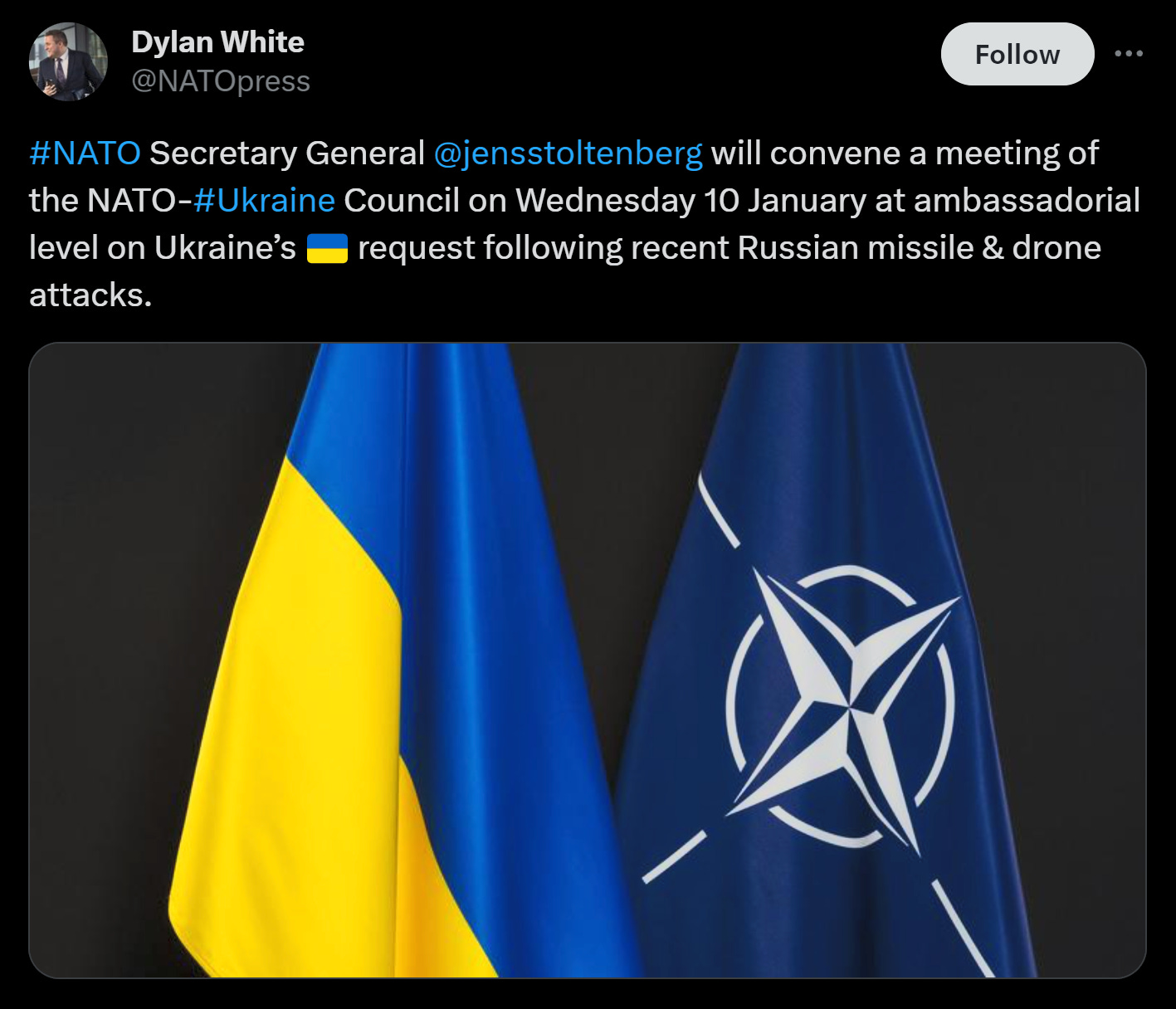Slava Ukraini! For the past six months I have provided a daily draft for the Ukraine War Brief Podcast collecting news from over 40 sources daily much of which ends up in the Ukraine War Written Brief. While this is going through a period of transition I will make this Draft available here for those who wish to keep up with events on a daily basis.
INSIDE UKRAINE
ALONG THE CONTACT LINE
GSAFU Morning Report
The General Staff of the Armed Forces of Ukraine in its situation update at 06:00 on Jan. 05 stated that it was The six hundred and eighty first day of large-scale invasion of the Russian Federation against Ukraine.
During the past day, 59 combat clashes took place. In total, the enemy carried out 7 missile and 36 air strikes, carried out 37 attacks from MLRS on the positions of our troops and populated areas. As a result of Russian terrorist attacks, unfortunately, there are dead and wounded among the civilian population. Residential buildings and other civilian infrastructure were destroyed and damaged.
Ukraine's defence forces have destroyed 6,000 Russian tanks to date
Russia has reached another milestone in its war of aggression against Ukraine. The aggressor continues to suffer enormous losses and as of Jan. 04 has had more than 6,000 tanks destroyed since the beginning of the full scale invasion. We will delve into this a bit.
Let's put this figure into perspective. At the beginning of the full scale invasion Russia had about 3,700 tanks in service in the entire country. Of course they had vast amounts of older models in various stages of storage.
Russia’s own estimates for tank production in 2023 were 2,100 according to an article in Defence Express quoting Russian sources. The same sources claim proudly that this was a “sevenfold increase” over 2022. A little quick math reveals that in 2022 Russia only produced 300 tanks.
Now if you add the 3,700 that they started with to the 2,400 they produced and then minus the 6,000 they have lost, you begin to see the problem. They would seem to have only a handful of tanks left.
The problem isn’t quite as severe as that because of course as we mentioned Russia had a vast number of older models in storage. They began to dip into this stockpile fairly early in the war. First older versions of the T-80 and T-72, then when those began to run out obsolete T-62s and finally resorting to post WW II tanks like the T-54/55.
It’s a good thing for them they were able to ramp up production of brand new tanks right? Wrong, their own production figures include T-54/55 and T-62 in those production figures, clearly these are not new production but refurbished tanks either from storage or cannibalised parts.
Some very interesting analysis comes from the Swedish research institute FOI, in its report on the military potential of russia after 1.5 years of war against Ukraine, estimates a much smaller annual tank production of around 520 new vehicles per year:
FOI estimates that Russia would be able to produce the following in 2023:
62 tanks, type T-90M Proryv, and 62 more of types T-90/T-90A;
80 tanks, type T-80BVM;
140 tanks, type T-72B3, and 140 more of T-72B3M modification.
It should of course be noted that there are no T-14 Armata included in these estimates; intelligence suggests the Armata program has been an abject failure. Even if it was not there are too many components that Russia would not be able to acquire.
Even the handful of new T-90Ms coming off the assembly line apparently do not have latest generation targeting computers, optics or night vision equipment.
In short Russia has been losing tanks since the beginning of this war faster than they can replace them, there is little prospect in today's economic climate that they will be able to reverse that trend and projecting forward will increasingly find themselves outgunned and outnumbered in both quality and quantity on the battlefield.
The Khortytsia operational-strategic group is responsible for the Kup’yans’k, Lyman, and Bakhmut axes, in the northeastern part of Ukraine.
In the Kupyansk direction, Ukrainian defenders repelled 4 attacks by the occupiers near Synkivka and east of Petropavlivka, Kharkiv region.
The enemy did not conduct offensive (assault) actions in the Lyman direction.
In the Bakhmut direction, our soldiers repelled 4 enemy attacks in Bohdanivka, Klishchiivka and Andriivka districts of Donetsk region.
The Tavria operational-strategic group is responsible for the Avdiivka, Mar’inka, Shaktars’ke, and Zaporizhzhia axes, in the central-eastern and southeastern part of Ukraine.
In the Avdiivka direction, Ukrainian defenders continue to restrain the enemy, firmly hold the defense, inflicting significant losses on the invaders.During the past 24 hours, the Defense Forces repelled 16 attacks near Novobakhmutivka, Stepovoy, Avdiyivka and another 16 attacks in the Pervomaisky and Nevelsky districts of the Donetsk region.
In the Mariinka direction, our defenders continue to hold back the enemy near Maryinka and Novomykhailivka, Donetsk region, where 7 attacks were repulsed.
In the Robotyne direction, the Defense Forces repelled 8 enemy attacks in the Robotyne and north-western Verbove regions of the Zaporizhzhia region.
The Odesa operational-strategic group is responsible for Kherson, Qırım, (also known as Crimea) and the Black Sea
In the Kherson direction, Ukrainian soldiers will continue measures to expand the bridgehead. Despite significant losses, the enemy does not stop trying to knock our units out of their positions. During the past day, the enemy carried out 6 unsuccessful assaults.
In the Kherson direction, Ukrainian soldiers will continue measures to expand the bridgehead. Despite significant losses, the enemy does not stop trying to knock our units out of their positions. During the past day, the enemy carried out 6 unsuccessful assaults.
TEMPORARILY OCCUPIED TERRITORIES
Russian Defence Ministry claimed to have repelled mass UAV and missile attack on Qiurim
The Russian Ministry of Defence claimed that on Jan. 04 Russian air defence systems have destroyed and intercepted 36 UAVs over Qirim.
Explosions were heard in the temporarily occupied town of Saky, and the occupiers reported an "attack".
Explosions were also reported near Sevastopol and Novorossiysk. A photo purportedly showing air defence systems responding in Novorossiysk in Russia's south was posted on social media.
Further explosions were reported in Sevastopol and Yevpatoriia . The Russian Ministry of Defence claimed to have destroyed 10 missiles over the peninsula.
THE HOME FRONT
Ukrainian economy shows resilience in 2023
A report by the United Nations Department of Economic and Social Affairs (DESA) on World Economic Situation and Prospects 2024 regarding the Ukrainian economy has been released.
The report reads that last year, Ukraine's economy demonstrated a certain resilience amidst the issues of the current war, especially in terms of interrupted electricity supply.
"There is a slight improvement this year, but this is an improvement on paper because the economy has already shrunk, and it's very painful," said Shantanu Mukherjee, Director of the Economic Analysis and Policy Division at UN-DESA.
The Ukrainian economy demonstrated a modest recovery in 2023, with GDP growth of 4.6% following a previous decline of 29.1%.
He added that the slight improvement does not signify a full economic recovery compared to the pre-war period.
THE RUSSIAN WORLD
Lukashenko signs off on Immunity, financial security and protection guarantees for himself and his family
Self-declared president of Belarus Alexander Lukashenko announced on his official website that he has signed amendments to the presidential law that, among other things, guarantee him immunity, lifelong protection, and property provided by the state upon his resignation from office.
The amendments bring the law into line with the updated Constitution and, among other things, determine guarantees for the president and his family upon the termination of his mandate.
Russia looks for ballistic missiles abroad as they are more effective in bypassing air defence systems
The Institute for the Study of War in its Jan. 04 Russian Offensive Campaign Assessment stated that Russia may be intensifying efforts to source ballistic missiles from abroad because these missiles appear to be more effective at striking targets in Ukraine in some circumstances.
Russian forces routinely use short-range ballistic missiles to strike Ukrainian cities closer to the frontline, and these missiles appear to be more effective at penetrating or avoiding Ukrainian air defences. Ukrainian air defences have intercepted 149 of a reported 166 Russian cruise missiles in intensified attacks since December 29, 2023, but have only intercepted a handful of the ballistic missiles that Russia has launched at Ukraine in the same period, for example.
Russian forces have repurposed S-300 and S-400 air defence missiles for conducting strikes against surface targets in Ukraine, and Ukrainian officials have acknowledged that Ukrainian air defences struggle to intercept these unorthodox missile attacks using their own S-300 and S-400 systems. Ukrainian forces have also appeared to be less successful in intercepting Iskander ballistic missiles during recent strikes, although Ukrainian forces did intercept an Iskander-M missile during a less intense series of Russian missile and drone strikes on December 30.
Ukrainian forces reportedly intercepted all Iskander-M or S-300/S-400 missiles that Russian forces launched at Kyiv on December 12. Ukrainian forces reportedly also intercepted all 10 Kinzhal missiles that Russian forces launched at Ukraine on January 2 with Western-provided Patriot systems. The effectiveness of Russian ballistic missiles thus appears to depend in part on the configuration of Ukraine’s air defence umbrella in the target area and the strike package of which the missiles are part.
The relative success that Russian forces have had in striking targets in Ukraine with ballistic missiles in combination with cruise missiles and drones may be prompting an intensification of Russian efforts to source ballistic missiles from abroad. Russia can reportedly produce roughly 42 Iskander missiles and four Kinzhal missiles per month, although it is unclear how many S-300/S-400 missiles Russia can produce. Russia‘s defence industrial base likely cannot produce ballistic missiles at the scale required for a persistent strike campaign in Ukraine that relies on regularly expending a large volume of ballistic missiles, and Russia likely has to source ballistic missiles from abroad if it wishes to maintain large-scale missile strikes against Ukraine.
NEWS WORLDWIDE
Ukraine's Foreign Minister says West could help Ukraine defeat Russia by taking five steps
Ukraine’s Foreign Minister Dmytro Kuleba, in an interview with CNN has urged Ukraine’s Western partners to speed up decision-making to continue supporting Kyiv in its defence against Russian aggression.
Kuleba said that he expected the West to commit to five measures that he thought would make a lot of sense and would help Ukraine secure victory over Russia.
"During the Cold War, the coalition that outcompeted the Soviet Union and its allies was by all accounts much weaker than the coalition that is now helping Ukraine to defeat Russian aggression," Kuleba said.
Kuleba said that the combined GDP of Ukraine and its allies is now 21 times higher than the combined GDP of Russia "and its very few allies", so there are sufficient resources to provide Ukraine with the assistance it is asking for.
He added that what "all the West has to do is start believing in itself" and its capacity to prevail, because time matters, and Ukraine cannot just wait while other countries hold "endless discussions" regarding their support for it.
"We call on everyone to expedite the decisions that are pending, that are in the pipeline, because the West has shown that it is capable of defending democracy. What needs to be done is the effort must be stepped up and expedited,"
— Dmytro Kuleba, Ukrainian Foreign Minister
NATO announces date of emergency meeting
NATO Spokesperson Dylan White announced that Secretary General Jens Stoltenberg has called for a meeting of the Ukraine-NATO Council at the level of ambassadors on the issue of the large-scale Russian air attacks that took place since the beginning of 2024. The meeting will take place on 10 January.
The meeting was requested by Ukraine following recent mass drone and missile attacks by Russia.
US promises to punish North Korea and Iran for helping Russia with ballistic missiles
John Kirby, US National Security Council Coordinator for Strategic Communications, during a press briefing on 4 January, reported that he United States has been preparing additional sanctions against those involved in the transfer of military assistance, including ballistic missiles, to Russia from North Korea (DPRK) and Iran.
Kirby noted that the United States has evidence of Russia receiving ballistic missiles from North Korea, as well as talks between Moscow and Tehran to receive similar weapons, which were also reported by the media.
"In response to Russia's activities with Iran and North Korea, we are taking several measures with our allies and our partners," he announced.
Among other things, the US wants to raise the issue of military cooperation between Pyongyang and Moscow at the UN Security Council, as it contradicts the Security Council resolutions Russia previously voted for.
"We will demand that Russia be held accountable for yet again violating its international obligations. Second, we will impose additional sanctions against those working to facilitate arms transfers between Russia and the DPRK and between Russia and Iran,"
— John Kirby, US National Security Council Coordinator
Kirby also promised that the US would continue to publish information and expose Russian arms deals in order not to allow other countries to "aid Russia's war machine in secret".
MILITARY & TECH
Germany sends Skynex air defence system, other military aid to Ukraine
Among the weapons supplied to Ukraine announced in the latest package delivered by Germany on Jan. 04 was a state of the art Skynex air defense system, two air surveillance radars TRML-4D, 30 drone detection systems, missiles for IRIS-T air defense systems, and 10 ground surveillance radars GO12.
Also included in Germany’s latest shipment is 10 Marder armored vehicles, ammunition for Leopard tanks, .155mm artillery ammunition, and munitions for firearms, two mine-clearing tanks and a bridge-laying tank, trucks, assault rifles, combat helmets, and winter camouflage nets and ponchos.
According to the Jan. 4 announcement, the German government plans to deliver to Ukraine four more IRIS-T air defense systems, another Skynex system with ammunition, 20 more drone detection systems, thousands of anti-tank mines, and other aid.
The Oerlikon Skynex® Air Defence System is Rheinmetall’s latest solution for short-range air defence. With its open and modular architecture, it sets new standards in terms of flexibility and expandability. The Oerlikon Skymaster® Battle Management System is the control node and centrepiece of the system. Various sensors and effectors can be linked in a modular way in order to fit mission requirements. One or several medium range radars, such as the Qerlikon X-TAR3D® Tactical Acquisition Radar, provide the air picture, which is consolidated in the control node. From there, air targets are assigned to autonomous effectors via the Skymaster network.
That’s it for today’s Draft folks if you would like to keep up with events in Ukraine daily please consider subscribing, its free!
Feel free to share this update with your friends. Heroyam Slava!






